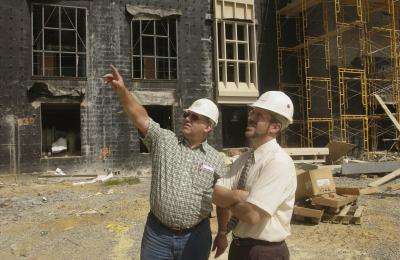Virginia Tech contracts with RMIT in Australia in effort to reduce US construction injuries

In the U.S. construction industry, almost two workers per day on average died while on the job, according to the latest available statistics from the U.S. Bureau of Labor for 2011. The real number for that year was 721 fatalities, the second highest of any U.S. industry.
"This number is unacceptable," said Brian M. Kleiner, director of the Myers–Lawson School of Construction at Virginia Tech. Kleiner focuses much of his research on construction safety, and some of his recent work includes looking at the efforts undertaken in Australia that seemingly provide a safer environment for its construction workers, at least according to the statistics.
The Aussies have fewer fatalities, and interestingly, record an injury rate per 100 construction workers that is approximately 43 per cent lower than figures from the U.S. in 2011 when its lost time rate was 3.9 recordable injuries per 100 workers.
Kleiner, director of the Center for Innovation in Construction Safety and Health, part of Virginia Tech's Institute for Critical Technology and Applied Science (ICTAS), has subcontracted with the Royal Melbourne Institute of Technology (RMIT) University in Melbourne, Australia. The partnership is providing some interesting insights into how the Australians operate differently from the U.S. in construction.
In this study, Kleiner, the Bogle Professor Fellow in the Department of Industrial and Systems Engineering at Virginia Tech, and his colleagues have found that in Australia, the concept of eliminating hazards or reducing risks at the design stage of construction projects has gained momentum since the national Occupational Safety and Health Strategy report of 2003-12 identified "eliminating hazards at the design stage" as one of its five national priorities.
"Furthermore, laws and regulations in Australia increasingly place responsibility for an accident on those who expose others to occupational health and safety risks that arise from their undertakings or activities. This contrasts with the United States where safety is typically left to the constructor of a project in order to avoid liability for dictating the means and methods to those performing the work," said Andrew McCoy, co-principal investigator on the project and assistant professor of the Building Construction Department at Virginia Tech said. McCoy is also a trained architect.
Based on this data and the relationship with RMIT, the National Institute of Safety and Health (NIOSH) awarded approximately $1 million over five years to Kleiner and his colleagues to study how the construction industry in the U.S. can improve its processes and practices, leading to improved safety and health of its workers. Specifically, Kleiner and his colleagues are looking at the development of occupational safety and health guidelines for the initial stages of design, especially, in the construction industry.
Kleiner and his graduate student, Lance Saunders, an industrial and systems engineering student, of Knoxville TN, McCoy, and Thom Mills, associate professor of building construction, are collecting case data from actual construction projects throughout the country. From this data, they are identifying patterns in the way the decision-making in design occurs among the various roles in the construction industry, as well as the mechanisms in place for the procurement and delivery of materials.
They are also attending project design meetings and interviewing personnel including the clients, project management teams, design consultants, contractors, construction workers, and their representatives. They are reviewing project documentation, and conducting follow-up surveys regarding communication and decision-making. Social networks are also being documented to isolate the critical communication patterns and interactions that lead to critical safety decisions.
With the data on various categories of hazards they have collected from case studies to date, their analysis has suggested that higher-level controls such as elimination and substitution of hazards occur with greater frequency when the constructor has more decision-making influence in the design stage of a project – already the ongoing practice with the Australian construction industry.
"In the U.S., safety is primarily left for the implementation or construction stage, relegated to the constructor, and control occurs through administrative systems and personal protective equipment, most typically. Also, communication between the constructor and the designer related to safety appears to be stronger in Australia than in the U.S., especially earlier in the construction life cycle at least at this point in data collection.
"The one exception to this statement appears to be collaborative projects in the U.S. in which the parties have a contractual relationship that promotes communication and supports collaboration towards safety as a goal of the project. We believe these types of projects are on the increase," Kleiner said.
From the results of their comparative studies, Kleiner, Saunders, Mills, and McCoy plan to work with construction industry personnel about how to integrate safety into the design process and thereby reduce the risk of injuries and fatalities for U.S. construction workers.
Provided by Virginia Tech